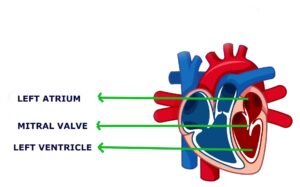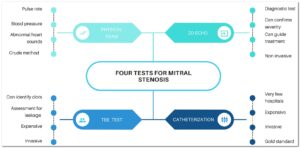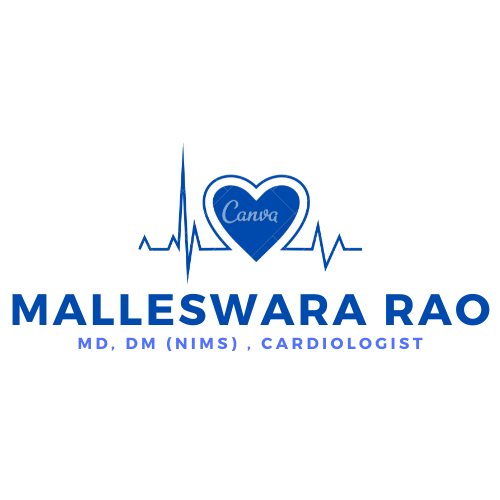Introduction: What is Mitral Valve Stenosis?
The Mitral valve is one of four valves of the heart which lies between the left atrium and left ventricle. It allows the free flow of blood from the left atrium to the left ventricle. At the same time, it prevents the backflow of blood from the left ventricle to the left atrium. Mitral stenosis is when there is a narrowing of the mitral valve, so blood flow is restricted from the left atrium to the left ventricle. Mitral stenosis is also called MS. It is often called rheumatic mitral stenosis as rheumatic fever is the most common cause.

In mitral stenosis, the mitral valve between the left atrium and left ventricle becomes thickened or narrowed due to an accumulation of calcium or other materials over time. This condition is most common in people who had rheumatic fever as children. In rheumatic fever, body immunity attacks the mitral valve while fighting against the bacteria. As a result, the mitral valve gets deformed due to scarring and deposition of calcium. This rheumatic fever is common in developing countries. Women are more often affected by mitral stenosis than men.
In developed countries, mitral stenosis affects people who are aged above 50 years. In developing countries, MS is common in the younger age group. Untreated rheumatic mitral stenosis can cause heart rhythm problems and a higher risk of stroke. People with mitral stenosis may develop heart failure and can die if proper treatment is not taken.
Symptoms of rheumatic mitral stenosis
Your symptoms depend on the severity of your disease. MS slowly progresses over time from mild to severe. You may be asymptomatic when MS is mild in severity. Moderate stenosis can produce no symptoms or mild symptoms especially if you have a pregnancy, infection, or anemia (low blood or low hemoglobin in the blood). Severe mitral stenosis almost always produces symptoms if you are an active person. Physically inactive people can have no symptoms or mild symptoms even with severe stenosis as they do not recognize the symptoms. Symptoms start appearing between the ages of 15 and 40, but they can occur even before or after this age.
Signs and symptoms of mitral valve stenosis include:
Most common symptoms
A. Shortness of the breath or Dyspnoea
The most common and often the only symptom of MS is Shortness of breath or dyspnoea. Shortness of breath may occur when you exert or lie down. Trouble breathing starts appearing in moderate to severe stenosis. You will out of breath when exerting yourself if you have MS.
B. Dizziness or fainting
C. Fatigue
Fatigue in mitral stenosis is due to the reduction in cardiac output due to narrowing in the mitral valve
D. Sensations of a rapid, fluttering heartbeat (palpitations) or heart flutter
Less common symptom
- Coughing up of blood
- Chest pain
- Swelling in your ankles or feet which can extend to thighs, tummy, and arms if neglected
- Brain stroke due to migration of the clot from the heart to the brain
- Hoarseness of voice due to compression of the nerve by enlarged left atrium. This is because one of the nerves that control your vocal cords runs next to your heart.
- Prolonged fever due to infection on the valve (rare)
- Gangrene of fingers or toes due to migration of the clot from the heart to the arm or leg.
Precipitants of symptoms
Patients with mitral stenosis who has a stable course can become unstable under certain circumstances.
Certain factors that may precipitate or worsen the symptoms of mitral stenosis are:
- Emotional stress
- Fever
- Lung infection, other infections
- Atrial fibrillation or AF
- Pregnancy
- Thyroid diseases
- Anemia or low hemoglobin
Causes of mitral valve stenosis
Causes of mitral valve stenosis include:
1. Rheumatic fever
This illness is caused by an infection of Streptococcus bacteria. Signs include fever, chills, joint pain, headache, and loss of appetite. This commonly affects school-going children. If untreated it can lead to permanent heart damage during adulthood. Your immune system attacks the mitral valve and other valves of the heart while fighting against an untreated Streptococcus bacterial infection. If Rheumatic fever affects you repeatedly, It can permanently damage your valve including the mitral valve by making them too thick, immobile, and heavy. This damage happens slowly over a period and gets worsened by Wear and tear due to age.
Mitral stenosis usually develops years or even decades after Rheumatic fever had infected you. Mitral stenosis does not become symptomatic for 20 to 40 years after you first had rheumatic fever.
2. Wear and tear of the age
Calcium deposits can occur in the mitral valve during an aging process This is called mitral annular calcification (MAC). MAC can rarely cause symptomatic mitral valve stenosis.
3. Radiation
Radiation to your chest area can rarely cause mitral stenosis
4. Congenital mitral stenosis
Sometimes babies are born with a narrowed mitral valve (congenital defect)
Complications of mitral valve stenosis
Untreated mitral valve stenosis will always lead to complications such as:
Complications of mitral stenosis are
a. Atrial fibrillation or Afib
The stretching and enlargement of your heart’s left atrium may lead to abnormal heart rhythm called Atrial fibrillation. If you’re experiencing atrial fibrillation or AFib, then your heart will beat erratically at rates between 100-250 beats per minute. Normal heart rhythm is regular whereas heart rhythm in Atrial fibrillation is irregular.
Atrial fibrillation or Afib is a rhythm abnormality where the heart beats chaotically, irregularly, and rapidly. AF is suggested by an irregularly irregular pulse on physical examination and confirmed by an electrocardiogram test (EKG or ECG test). Atrial fibrillation is common in patients with MS. The incidence of AF is higher with more severe disease, increasing age, and the presence of other valvular abnormalities. If you are under 30 years, the chances of having atrial fibrillation are just 4 to 7 percent but when your age is above 50 years, the prevalence may increase to almost 50 to 60 percent.
Atrial fibrillation or Afib turns the course of mitral stenosis and its onset may precipitate symptoms in asymptomatic patients.
Atrial fibrillation or Afib causes symptoms like sensations of a rapid, fluttering heartbeat (palpitations), dizziness, tiredness, and shortness of breath. Atrial fibrillation makes the blood clot in the left atrium. This clot can detach from the site and dislodge in the brain, kidney, spleen, leg, or arm. The organ that gets the clot becomes gangrenous if the clot is not removed promptly. This is called thromboembolism.
b. High blood pressure in the lung arteries (pulmonary hypertension)
Increased pressure in the arteries that carry blood from your heart to your lungs (pulmonary arteries) is a common complication of mitral stenosis. this is due to backward transmission of raised pressure in the left atrium. This is called PAH or pulmonary artery hypertension. pulmonary artery hypertension is diagnosed by echocardiogram test (2d echo test) The development of PAH makes the right heart work hard which eventually can lead to right heart failure.
c. Congestive heart failure
Lung congestion can occur due to increased pressure in the vessels of the lung due to backward transmission of raised left atrial pressure. This is called left sided heart failure. High blood pressure in the lung arteries (pulmonary hypertension) strains the right side of the heart, which may lead to failure of the right heart also. Right sided heart failure leads to swelling of ankles, and feet. Congestive heart failure develops only in the advanced stage of mitral stenosis. unfortunately, survival is just 2 to 3 years once you develop heart failure. This is a kind of left heart failure with normal ejection fraction. Acute heart failure gets precipitated if you get severe infection in the lungs or the body.
d. Lung congestion (pulmonary edema)
Moderate to Severe Mitral stenosis leads to Build up of blood and fluid inside your lungs. you will experience symptoms such as shortness of breath, cough, or chest pain. You may cough up blood-tinged mucus also. A chest x-ray can detect lung congestion. Medicines that increase your urine output (diuretics) can help you relieve lung congestion.
e. Heart enlargement
The pressure buildup in your heart’s upper left chamber (left atrium) in mitral valve stenosis. this will stretch your left atrium and makes it big. It even results in enlargement of your pulmonary artery and right side chambers of the heart such as the right atrium and right ventricle again due to stretch-induced by excess pressure in them.
f.Blood clots
AF (Atrial Fibrillation) causes blood clots to form in the upper left chamber of your heart (left atrium). This is especially dangerous because it can lead to brain strokes. Blood clots can breaks free from the heart area, it can travel to other parts of your body such as the brain, legs, kidneys, and arms. if a clot blocks a blood vessel in your brain, you will get a brain stroke. Then how do you stop embolism? One way is by taking blood thinners.
Test for mitral stenosis

If your doctor suspects mitral valve stenosis, you’ll likely undergo additional testing to confirm and pinpoint the severity of your condition. Here are some of the diagnostic tests commonly used by doctors to diagnose mitral valve stenosis or MS and its severity.
I. A physical exam
- During the physical examination, the doctor will listen to your heart through a stethoscope, looking out for murmurs or abnormal sounds that could indicate mitral stenosis or MS. A physical exam will also include measurements of your blood pressure, heart rate, weight, and height. If you have mitral stenosis (MS), your blood pressure might be low. If you have mitral stenosis, your pulse rate may be high. Your pulse rate become irregular if you develop an abnormal heart rhythm. This is called atrial fibrillation.
II.Electrocardiogram (ECG)
- An electrocardiogram (ECG) measures electrical activity in your heart. It can identify enlargement of heart chambers which can occur in mitral stenosis. very helpful in identifying the complications of mitral stenosis such as atrial fibrillation or enlargement of the left atrium. It’s usually not enough for a complete diagnosis and does not help in diagnosing mitral stenosis. it gives some clues to your doctor to predict mitral stenosis in you.
III.Two-dimensional echocardiogram
A two-dimensional echocardiogram is a non-invasive diagnostic test that can be used to diagnose mitral stenosis. This test uses sound waves (echoes) and produces a moving picture of your heart. To get an accurate diagnosis, you’ll be asked to lie on your back while an ultrasound probe is placed on your chest. This test helps to diagnose mitral stenosis and assess the severity of the stenosis. The degree of stenosis is graded as mild, moderate, and severe based on echocardiogram measurements. You need to undergo further tests if your stenosis is severe.
IV.Chest x-ray
- Chest X-ray uses x-rays to see inside your body. Mitral stenosis produces characteristic changes in the shape or structure of your heart which can help your doctor make the diagnosis and management plan.
V.Cardiac catheterization
The most common test used to evaluate suspected mitral stenosis is cardiac catheterization. In cardiac catheterization, doctors insert a thin, flexible tube called a catheter into an artery in your groin. The catheter is guided through blood vessels and positioned across a heart valve to measure the pressure gradient between the left atrium and left ventricle. This test is done as a part of balloon surgery. It means you are likely to undergo balloon surgery at the same time as the cardiac catheterization. During the cardiac catheterization, even a coronary angiogram is done if you’re over 40 years old to assess coronary artery disease.
Can Rheumatic MS be cured?
Mitral stenosis can’t be cured as it is permanent mechanical damage to your mitral valve. Interventions reduce your symptoms and prolong your life. medication can also be helpful to delay the progression of rheumatic disease, prevent recurrent attacks of rheumatic fever, reduce symptoms, prevent the formation of the clot inside the heart, and controlling the heart rate
Some of the possible treatments include:
-
Medication
You may be prescribed the following medications by your doctor after you got diagnosed with mitral stenosis
- Drugs that increase your urine output (reduce your swelling from too much fluid, reduce your shortness of breath)
2. drugs that control heart rate (fast heart rate produces more symptoms in mitral stenosis)
3. Blood thinners like warfarin (to prevent clot formation in the left atrium once you develop atrial fibrillation).
4. Long-term course of antibiotics ( prevents rheumatic fever recurrence )
- Catheter-based procedures
- Cardiologist inserts a thin, flexible tube called a balloon into an artery in your groin. The catheter is guided through blood vessels and positioned across a heart valve. Here, your doctor inflates the balloon which loosens or tears apart the tissue between the valve. in this way, the procedure widens the narrowed valves and allows easy egress off the blood from the left atrium to the left ventricle. This is a palliative procedure and your disease may recur in the next 5 to 10 years. You may need surgery or balla oon again at that time.
-
Surgery:
When your mitral valve is severely damaged and calcified, it is not suitable for a balloon procedure. In such a case, your doctor will advise an open heart surgery called mitral valve replacement
Mitral valve replacement surgery
Mitral valve replacement surgery or MVR procedure is one of the most common heart surgeries done today. This surgery helps people who suffer from mitral stenosis. I am successful at relieving the symptoms.
your cardiothoracic surgeon can replace your damaged mitral valve with a new valve by using many different methods, including minimally invasive surgery or robotically assisted surgery.
Your surgeon may repair or replace the valve whichever suits you.
What types of replacement valves are there for mitral stenosis, and why choose one over the others?
- Bioprosthetic valve: These are also called bioprosthetic valves as they are made from animal tissue ( such as pigs or cows). You need not have to take blood-thinning medications if you had this valve. Unfortunately, They last about 15 to 20 years. Hence you may need surgery again. Hence it is recommended for people aged above 60-65 years
- Mechanical valve: As the name suggests, they are made up of a metal that is compatible with the human body. They do not degenerate which means they last longer. As they are metals, they are prone to clots formation on top of them. These clots can block the valve and cause heart failure or death. These clots can migrate to the brain and cause strokes. Therefore, you will need to take blood-thinning medicines for life long. this is ideal for young patients with mitral valve stenosis.
What else can I do to manage mitral stenosis?
For mild to moderate stenosis, you will need preventive antibiotics for rheumatic fever For this, you need to take a Penicillin injection every 3-4 weeks. You may need to take these for more than 10 years.
If you have severe mitral stenosis, you need intervention. you are recommended to consume a low-salt or low-sodium diet.
If you develop atrial fibrillation or a clot in the heart, you will be given blood thinners for the rest of your life.
In mitral stenosis, you may need to take medicine to slow your heart rate. The ideal heart rate in mitral stenosis is between 60 to 70 bpm.
Blood pressure and diabetes should be kept under control. Avoid alcohol and quit smoking. Consume a heart-healthy diet.
Prevention of mitral valve stenosis
Treating sore throat caused by streptococcus promptly will prevent most cases of mitral stenosis. Do not neglect the sore throat of your kid. Taking antibiotics for the long term if advised by your doctor can prevent or delay the development of mitral stenosis. Improving dental hygiene, following a healthy diet, and avoiding overcrowding also prevent most cases of rheumatic fever.
If you are looking for the best treatment for mitral valve stenosis in Hyderabad, contact Dr. Malleswara Rao
Where will I get best treatment for Mitral valve stenosis (MS) in Hyderabad?
Dr. Malleswara Rao is a reputed heart specialist for mitral stenosis with vast experience in diagnosing and treating Mitral valve stenosis in Hyderabad. He is affiliated with many Hospitals in Hyderabad.

Pingback: What is a 2d echo with Doppler in Hyderabad ? - ECG 2D ECHO TMT CARDIOLOGIST HYDERABAD
Pingback: TMT test in Hyderabad - ECG 2D ECHO TMT CARDIOLOGIST HYDERABAD
Pingback: What is a 2d echo with a Doppler in Hyderabad ? -
Pingback: Balloon Mitral Valvotomy For Mitral Stenosis - CARDIOLOGIST HYDERABAD